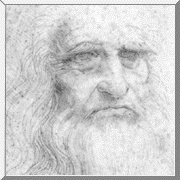 Leonardo
da Vinci, was born
Lionardo in Vinci "on Saturday, 15 April, at three o'clock
in the morning" in 1452. The best records of his life are found in
his own manuscripts, although the details of his birth were recorded
by his paternal grandfather.
Leonardo
da Vinci, was born
Lionardo in Vinci "on Saturday, 15 April, at three o'clock
in the morning" in 1452. The best records of his life are found in
his own manuscripts, although the details of his birth were recorded
by his paternal grandfather.
As a scientist, Leonardo is best known for his shrewd powers of observation and grasp of the problem. It was common at the time for artists to carry out dissections to aid in their art. Leonardo studied the structure of the human body and documented his findings in many anatomical drawings. In order to understand the functions of the body, he compared human anatomy with that of other mammals. This started the discipline of comparative anatomy. He made remarkable observations of astronomy. He realized that the earth is not at the center of the universe, rather it revolves around the sun, and rotates on its axis. He created a lunar clock which clearly shows the principles.
Leonardo as an artist is known for works such as "The Last Supper", and the "Mona Lisa". Leonardo as an inventor is known for designs of hydraulic machines, various war machines, clockworks, a paddle boat, and of course, the parachute and flying machine.
A truly remarkable man, he died on May second, 1519.
Designed by: Bill Hepburn
Letze, O., Buchsteiner, T. (Eds.). (1998). Leonardo da Vinci Scientist Inventor Artist. Tübingen, Germany: Institut für Kulturaustausch Reutlinger Str.
McLanathan, R. B. (1966). Images of the universe; Leonardo da Vinci: the artist as scientist. Garden City, NY: Doubleday.
Goldstein, T., (1980). Dawn of modern science: from the Arabs to Leonardo da Vinci Boston: Houghton Mifflin
The Leonardo Museum. [On-Line]. URL: http://www.leonet.it/comuni/vinci/